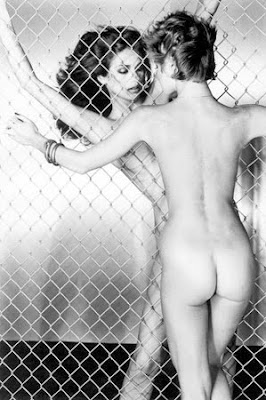
Fetching Is Your Dior,Christian Dior ad with Lisa Taylor, 1976


Gia Carangi getting tattooed, 1975

Fetching Is Your Dior,Christian Dior ad with Lisa Taylor, 1976

Christian Dior sunglasses ad, 1976
Chris Von Wangenheim is one of the greatest fashion photographers.
Glamour, Sex and violence were the principal ingredients for the German photographer.
His hard, sexy, decadent images survive among the most exemplary
illustrations of the high-glamour look of the 1970s.
During a period, when fashion photography was focusing on sexual, and often violent,
subject matter—a response to the Women’s Lib Movement,and the rise of punk.

Marie Helvin on her head, 1975
Von Wangenheim’s dangerously seductive photos stood out as some of the most decadent.
His sensibility precisely matched the new fashion trends, whose most distinguished photographic exponents were Helmut Newton and Guy Bourdin.
Men dancing on beach, 1975

Born the son of an aristocratic German officer in Berlin in 1942,
von Wangenheim infused his work with the strong influence of his German roots.
His pictures, like those of his hero and mentor—and fellow Berliner—Newton,
carry echoes of the decadent aspects of Weimar Berlin.
There are references to German Expressionist cinema in his use of low lights
that cast dramatic shadows, and there is a cool, even cruel edge to his scenarios
that hints at an element of cultural and personal trauma.
A cold sexism, often with a sadistic edge,
defines von Wangenheim’s preference in depicting women.
In an interview, He quotes :
"I realized that getting my picture was more important to me
than the disconfort of someone not understanding
or someone's opposition to my goals."


Von Wangenheim created strong and memorable images,
often with disconcerting ingredients:
One for Vogue featured an elegant foot in a high-heeled shoe kicking in a television screen; another, for Dior, showed a model with her arm locked in the jaws of a savage-looking dog.

He succeeded in constructing images revealed a more sinister side of glamour.
“A good fashion photograph,” he wrote in 1980,
“makes a promise it can never keep.”
At the peak of his success Chris von Wangenheim died in a car crash in 1981.
Oct 1978 -Gia Marie Carangi - fence

Reigning is your Dior, ad with Gia



 Intriguing is your Dior, ad
Intriguing is your Dior, ad
Gia and models in the California desert, 1979
 Oct 1978 - Gia Marie Carangi & Sandy linter - Nude
Oct 1978 - Gia Marie Carangi & Sandy linter - Nude

























 Intriguing is your Dior, ad
Intriguing is your Dior, ad









































